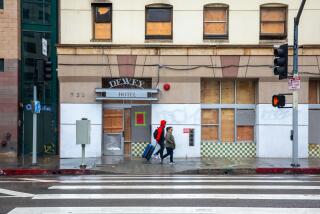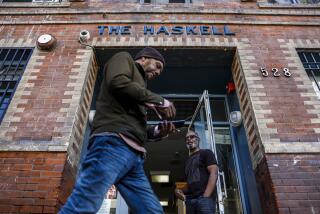Column: Alice Callaghan: Pushing out the homeless isn’t a solution

Portrait of Father Alice Callaghan, at Las Familias Del Pueblo, in Los Angeles on July 8. Dubbed “Father Alice” because she is both an Episcopal priest and a former nun, Callaghan is best known in City Hall circles for her politically savvy lobbying on behalf of the poorest of the poor.
The mantra in the real estate biz is location, location, location. It’s pretty much the same thing in Alice Callaghan’s line of work — housing, housing, housing ... on skid row. The former Roman Catholic nun turned Episcopal priest has spent nearly 35 years single-mindedly working to bring to the homeless some of the same advantages — starting with a roof over their heads — that other Angelenos enjoy. Callaghan, who also runs skid row’s Las Familias del Pueblo, a service center for immigrant families and children, was, in her teen years, a Newport Beach surfer girl; now she navigates the tricky waters of public policy and the politics of homelessness.
What do you think of the new L.A. ordinances giving the homeless less time to move their possessions or have them seized?
I’m not even sure the City Council has any idea what they mean. The city’s overriding concern is not solving the homeless problem but the visibility of the homeless.
Why are they so visible now?
On skid row in the 1960s, we had almost 10,000 affordable housing units, SROs [single-room occupancy hotels]. A general relief check used to cover the rent. They were occupied by the same kind of people who are now on the street. By the 1980s we were down to about 6,700 [units]. Now, in the 50-block [skid row] area, we are down to just 3,600 SRO units. When people say, “Why are all these people on the sidewalk?,” there’s a simple mathematical equation: They’re on the sidewalks because we have eliminated their housing.
What happened to it?
The change began at Fourth and Main. More than a third of all the housing on skid row had been on Main. [Developer] Tom Gilmore bought a building that was not at that point housing, but by buying that building and converting it into upper-scale housing, it changed the real estate dynamic all the way down Main. Then it became almost impossible for nonprofits to secure housing because now landlords have dollar signs on the horizon. It resulted in the conversion of SROs. It was a domino effect. And the city did nothing.
In the past, the city redevelopment agency had a plan to save skid row housing, to fix it up, to maintain it, because the city understood then that if you didn’t house people on the row, you couldn’t solve any other problems in downtown. That plan lost support in the late ‘80s. With term limits, there were no champions left, the redevelopment agency began to lose its power and downtown became laissez-faire economics, which it is to this day.
New York announced a $41-billion, 10-year plan to save housing, with an emphasis on the lowest[-income] 25%. We have no plan out of City Hall. I don’t think our city has the slightest interest in the homeless except for visibility. [And yet] if you eliminate the housing, you are now saying the de facto housing for the homeless of this city for decades will be on the sidewalks.
The homeless on skid row are not going to go anywhere — they have nowhere to go. And their numbers will increase as we continue to eliminate housing.
A county program provides housing at the same time it treats people for drugs, drinking or mental health problems.
That service-enriched housing becomes very expensive. You could do four or five times as much housing if you weren’t doing service-enriched housing. The other issues are secondary to housing people. Nobody wants to talk about affordable housing because it moves the burden from the homeless person to the city. So the city prefers to talk about the homeless as people with problems, as though that’s what keeps them from being housed.
Shouldn’t the public be able to specify the terms on which people are housed on the public dollar, like getting treatment?
Yes, there are plenty of addicted and mentally ill on the sidewalk, but plenty [are] just poor people: 600 used to live at the Cecil; the King Edward and Baltimore [hotels]. All those units are gone. Shelter is a fundamental right, like food. Every citizen has a right to affordable shelter, and if you don’t provide that, don’t get upset that they are occupying the public domain.
Don’t the shelters fill the gap left by disappearing SRO units?
If a shelter has an empty bed, it tells you more about the [shelter] than about the homeless person who won’t go in. If I were homeless, I’d find a couple of friends and get as far out of view as we could. We would not go to one of the missions with 300 in a room; people who are mentally ill, who are sick, who are yelling all night. [The shelters] are not safe. A couple of years ago, some Buddhist monks slept one night in a mission and they wouldn’t go back.
How has policing on skid row changed over the years?
The last time we had really good policing was in the early ‘80s. If something happened on the row, they would go out with us right away and sort it out.
Mayor Garcetti says he wants changes in the new laws to protect documents and medications. He’s said the homeless are “my people” too.
To him the misery of the poor is not going to hold captive the gentrifying desires of the rich downtown.
The solutions are decades away, but in the meantime, people are going to be on the sidewalks. So we need more public restrooms. We need to allow [charities] to feed people on the sidewalks.
Los Angeles probably won’t be dedicating $41 billion to housing, as New York is. What could the city do without more money?
We should use every single zoning variance, every public dollar we have to make sure every existing unit is not converted to upscale activity. The city has to announce its commitment so developers know it’s hard to develop in this area, it’s hard to buy an SRO and upgrade it — go somewhere else.
The city attorney could say, Mr. Mayor, I am not going to prosecute a single person you arrest or give a ticket to under these ordinances or any others that are cruel to the homeless.
But the city has no interest in doing that. Gentrification is on a roll. Pico Union, with one of the highest densities in L.A., is being gentrified. Where are poor families there going to go?
Isn’t mixed-use housing one answer?
If you’re taking a Housing 101 course at UCLA, it looks good on paper, but the fact is nobody’s going to feel great living in proximity to someone who’s maybe a mentally ill transvestite drug addict. People don’t even want them on the same block, so why would they want them in the same building? When they do mixed housing, it’s almost all elderly. The elderly look better.
I read somewhere that you like the idea of skid row as a community for the homeless. What should it look like?
The SROs — fix them up. Provide an improved social service network. Skid row is the place you go when you have no money and no family. It’s where you find free or cheap housing, free food, free clothes.
The plan [from the 1970s] was very enlightened. It was not to create a ghetto. You would protect the housing, you wouldn’t put in retail, you’d put in other activity — like light manufacturing. That plan got abandoned.
Homeless people are no different from the rest of us: “I don’t care if I have a bathroom down the hallway, if I just had a private space to live my own private life, that’s all I want.” That’s all most people want.
This interview has been edited and condensed. patt.morrison@latimes.com
Twitter: @pattmlatimes
Follow the Opinion section on Twitter @latimesopinion and Facebook
More to Read
A cure for the common opinion
Get thought-provoking perspectives with our weekly newsletter.
You may occasionally receive promotional content from the Los Angeles Times.







